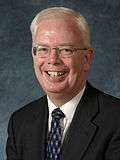Deputy First Minister of Scotland
The Deputy First Minister of Scotland (Scottish Gaelic: Leas-Phrìomh Mhinistear na h-Alba; Scots: Heid Meinister Depute o Scotland) is the Deputy to the First Minister of Scotland. The post-holder deputises for the First Minister of Scotland in period of absence or overseas visits, and will be expected to answer to the Scottish Parliament on behalf of the First Minister at First Minister's Questions.
| Deputy First Minister of Scotland Leas-Phrìomh Mhinistear na h-Alba | |
|---|---|
 | |
| Appointer | First Minister of Scotland |
| Term length | Scottish Parliamentary Elections are held every five years. The Deputy First Minister is appointed by the First Minister. No term limits are imposed on the office. |
| Inaugural holder | Jim Wallace |
| Formation | 7 May 1999 |
| Website | www |
 |
|---|
| This article is part of a series on the politics and government of Scotland |
|
Scottish Parliament Elections
UK General Elections
|
|
Intergovernmental Relations
Boris Johnson (C) Rishi Sunak (C)
Alister Jack (C)
|
|
Administration |
|
|
Functioning responsibilities
The post is not recognised in statute (in comparison with the post of First Minister which is established by the Scotland Act 1998), and its holder is simply an ordinary member of the Scottish Government. The post has nonetheless existed since the establishment of the Scottish Parliament and Scottish Government in 1999. When one party governs alone, the Deputy First Minister is a senior member of the governing party, typically the party's deputy leader. When the government is formed by a coalition, the Deputy First Minister is usually the leader of the minority partner.
The Deputy First Minister, within the Scottish Government, has direct responsibility and control over the strategy of the Scottish Government, delivery and outcomes of ministerial portfolios, resilience, as well as cross-government co-ordination of public service reform.[1] Alongside the responsibilities of the post-holders functions as Deputy First Minister, the post holder is also required to have direct responsibility for a cabinet secretary post. The current Deputy First Minister, John Swinney, is also Cabinet Secretary for Education and Skills.
Nomination and election
The Additional Member System used to elect Members of the Scottish Parliament makes it difficult for a single party to have an absolute majority. Between 1999 and 2007, the Scottish Executive was formed by a Labour and Liberal Democrat coalition, with the leader of Scottish Labour serving as First Minister and the leader of the Scottish Lib Dems serving as Deputy First Minister.
Although the Scottish National Party (SNP) formed a single party minority administration following the 2007 election, the post was not abolished despite there being no need to recognise the status of a second party leader, instead being given to the SNP's depute leader, Nicola Sturgeon.[2] When Sturgeon became First Minister, the party's depute leader, Stewart Hosie, was serving in the Parliament of the United Kingdom and did not have a seat in the Scottish Parliament. The Deputy First Minister's post thus went to John Swinney.
Acting First Minister
During the illness of the first First Minister, Donald Dewar, the Deputy First Minister took over the running of the Executive as Acting First Minister.
List of Deputy First Ministers
| Name | Portrait | Term of office | Party | Other offices held whilst in post | First Minister | ||||
|---|---|---|---|---|---|---|---|---|---|
| Jim Wallace |  |
17 May 1999 | 23 June 2005 | Liberal Democrats | Minister for Justice (1999–2003) Minister for Enterprise and Lifelong Learning (2003–2005) |
Donald Dewar | |||
| Henry McLeish | |||||||||
| Jack McConnell | |||||||||
| Nicol Stephen |  |
27 June 2005 | 16 May 2007 | Liberal Democrats | Minister for Enterprise and Lifelong Learning | ||||
| Nicola Sturgeon |  |
17 May 2007 | 20 November 2014 | Scottish National Party | Cabinet Secretary for Health and Wellbeing (2007–2012) Cabinet Secretary for Infrastructure and Capital Investment (2012–2014) |
Alex Salmond | |||
| John Swinney | .jpg) |
21 November 2014 | Incumbent | Scottish National Party | Cabinet Secretary for Finance, Constitution and Economy (2014–2016) Cabinet Secretary for Education and Skills (2016–present) |
Nicola Sturgeon | |||
References
- https://beta.gov.scot/about/who-runs-government/cabinet-and-ministers/deputy-first-minister/
- "Salmond announces his new cabinet". BBC News. 16 May 2007. Retrieved 16 May 2007.
